Educational STEM workshops for middle school and high school students
Scientists and engineers have super-fun jobs but many people don't know much about what they do.
An engineer/scientist/magician will describe these professions while using highly-interactive magic-based experiments to demonstrate several key STEM concepts.
Students will learn why experiments are done and then will help design experiments to solve magical mysteries.
Students will also learn how engineers solve problems and then will help test magical prototypes to discover if these new inventions are working as intended.
The overarching theme is that the more scientists and engineers there are with different backgrounds and skill sets working together, the more they can change the ordinary into something extraordinary.

Workshops presented by Dr. John Gyllenhaal, Engineer/Scientist/Magician
For over twenty years, John has been part of a fantastic team of engineers and scientists working on the world's fastest supercomputers at Lawrence Livermore National Lab (LLNL).
At the end of high school, John had no clue about what engineers or scientists did but really didn't want to be one.
A string of good luck allowed him to discover that engineers and scientists have the coolest jobs!
John went on to earn a Ph.D. in electrical engineering with a focus on designing high-performance computers. He has published more than 30 scientific papers and was granted a computer technology patent.
Shortly after joining LLNL, John started down the path of also becoming a sleight-of-hand artist and close-up illusionist.
At John's 20 year high school reunion, he was surprised how many classmates recounted how they "by accident" fell into their high-tech careers.
One extremely artistic friend from high school that was now a successful computer programmer exclaimed "who knew these jobs were so much fun!"
This is one of the motivations for his efforts to give students insight into why they might want to be an engineer or scientist.

Fantastic Wild STEM Magic workshops for conference rooms, classrooms, and Zoom
After many years of volunteering at LLNL community events, John was asked in late 2016 if it was possible to develop an educational 20-minute magic show for STEM day at the lab.
He found performing eight Wild STEM Magic shows in three hours for all those middle school students to be an amazingly rewarding experience.
John was then told about the opportunity to expand his new STEM show into a 75-minute workshop for the LLNL-sponsored San Joaquin Expanding Your Horizons conference for middle and high school students.
After six months of intense development, John's 75-minute Wild STEM Magic workshop premiered in Sept 2017 to a great response.
The main feedback John received from the students was they wished it was longer! By 2020, John had developed three distinct in-person STEM workshops, providing him with over 2 hours of STEM workshop material to pull from.
John's educational STEM workshops consists of a series of highly-interactive magic-based experiment, demonstration, and exercise modules designed to be performed in a space filled with students in chairs (such as a conference room), so students can be very close to the action and participate easily.
Classrooms with desks also work well.
The in-person workshops accommodate up to 28 middle or high school students and can be scheduled back-to-back in the same room with 5 minutes of reset time between them. John can perform several workshops in a row to cover an entire grade's students.
The Zoom version of the "The Science and Engineering Behind Illusions" workshop was developed in 2020 to accommodate up to 48 students on individual devices to replicate the fully interactive in-person experience for the virtual Expanding Your Horizons conferences.
In 2021, an less-interactive but much more scalable and flexible version was developed that has no device limit (two ~1000 device workshops successfully presented in 2021) and that supports any mix of a device per classroom and a device per student desired.
Any teleconferencing technology can now also be used (Zoom, Teams, WebEx, Google Meet, etc.) since OBS (Open Broadcaster Software) is now used to drive this highly-polished and engaging virtual STEM workshop.
NOTE: For this illusion workshop, virtual or in-person, every student receives (and requires) an illusion kit that allows the construction of several amazing illusions that are explained during the workshop.

Workshops of almost any desired length available
The 120+ minutes of available modules can be combined to create one or more workshops of almost any desired length.
A common short workshop with good coverage is 25 minutes long and contains the modules: Intro 1, Science 1, Demo 1, Engineering 1, and Wrap up 1 (modules described below).
Three completely distinct, coherent, and self-contained 40 minute STEM workshops can be presented to the same students.
The modules can also be used to create coherent single 75 minute or 90 minute workshops, as shown below for John's February 2019 EYH workshops.
Example: Modules used in John's 90-minute Feb 2019 EYH STEM workshops
The modules below are listed in the order they were performed in February 2019's 90-minute TVEYH workshops.
Additional workshop modules from earlier workshops are described afterwards.
Intro 1: Scientists and engineers have the coolest jobs!
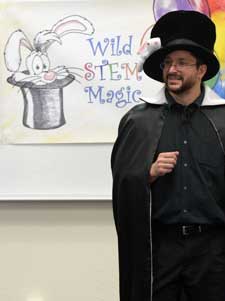
- Introduces John, the Wild STEM Magic workshop, and what scientists and engineers do
- John works on the world's fastest supercomputers at Lawrence Livermore National Laboratory
- 2 minutes long (all module times approximate)
- Key concepts:
- Scientists figure things out and tells others what they have learned
- Engineers use what they have learned to fix, improve, or invent new things
- Both do a lot of experiments but usually with different goals in mind
- Scientists aim to learn more about something through experimentation
- Engineers aim to learn more how to do something through experimentation
Science 1: Dot the escape artist
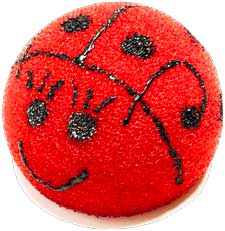
- Experiments with an amazing ladybug illustrate what scientists do
- 6 minutes, 3 assistants used
- Key concepts:
- Scientists can and do study practically anything, including ladybugs
- Unexpected results are exciting because they often lead to learning new things
- Publishing just means telling other scientists and engineers what you learned
- Future experiments are driven by current theories and burning questions
Demo 1: Challenging assumptions
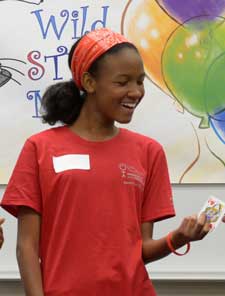
- Three-card Monte demo shows how false assumptions can lead you repeatedly down the wrong path
- 7 minutes, 6 assistants used
- Key concepts:
- Falsely assuming something is impossible makes it hard to detect that it is happening
- Scientists and engineers are trained to challenge assumptions
- Teams need folks with different backgrounds, worldviews, and skills
Engineering 1: Testing new switch tech
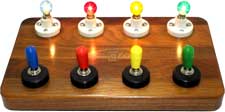
- Students help thoroughly test a prototype light switch technology that is found to work perfectly, even for impossible test cases
- 6 minutes, interaction with 9+ students
- Key concepts:
- Engineers experiment on equipment to see if it is working correctly
- This is significant portion of John's job working with LLNL's huge supercomputers
- Have other engineers test once you think something is completely working
- Testing edge cases and undefined behavior is important part of what engineers do
Engineering 2: Testing a time-flux capacitor
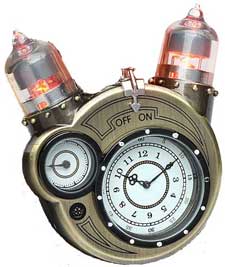
- Students help test a new technology that claims to slow the flow of time
- Amazing initial test results are found to not actually prove the claims
- 10 minutes, 3 assistants plus everyone repeats cool demo
- Key concepts:
- Perfect measurements are not possible, error bars represent likely error magnitude
- Changes in measurements have to be outside error bars to be significant
- Must rule out known phenomena before claiming a new discovery
Exercise 1: Student-led science experiments
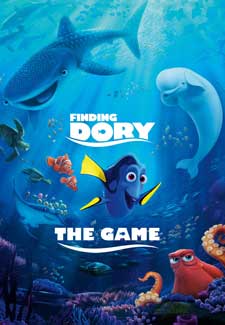
- Students design experiments, test conditions, and controls to test theories on how John always knows which card they selected
- 7-15 minutes, 6 (or all) assist (depending on time allocated)
- Key concepts:
- Scientists investigate intriguing mysteries like this one
- They design experiments to prove/disprove theories and answer questions
- Scientists sometimes find tiny changes can signal big things
- Engineers often work with scientists to design equipment to accurately measure these tiny changes
- Isolating key variables is a good first step in discovering how something works
Exercise 2: Reverse engineering the cork trick
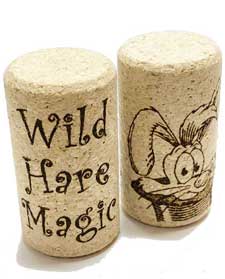
- Students attempt to reverse engineer the cork trick for three minutes
- The cork trick is then taught and the students may take home both corks
- 8-10 minutes, all students participate
- Key concepts:
- Everyone constantly learns by reverse engineering existing approaches
- Engineers actively investigate solutions made by others and those found in nature
- Even vague descriptions can significantly accelerate solution discovery
- Hints about setup and limitations can dramatically narrow search space
- Sometimes new and better solutions are found when working from incomplete descriptions
Demo 2: Play can lead to innovation
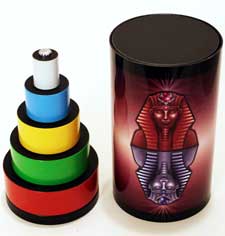
- The value of play is illustrated with a "self-righting pyramid" trick that was made to actually work through clever engineering
- 4 minutes
- Key concepts:
- Engineers playing with tech often leads to new skills and even inventions
- The cork trick solution from exercise 2 could be used by robots to exchange items efficiently
- Sometimes a good solution is found first and then matched to a problem needing solving
Science 2: The science of illusion
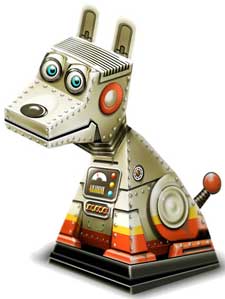
- An amazing hand-held 3D illusion is demonstrated and explained where the robot dog's head twists dramatically as the robot dog is rotated
- All students get an build-it-yourself kit for the illusion to take home
- 7 minutes, all students participate (would need an extra 15 minutes to build kits during workshop, plus scissors and tape for everyone)
- Key concepts:
- Most illusions are a side effect of how your brain extensively processes sensory input
- Your brain can fill in perception gaps incorrectly due to incorrect assumptions
- Notice how your brain patches up the discrepancy between the head's and body's movement
- Illusionists and sleight-of-hand artists use this extensively to make impossible things appear to happen right in front of you
- For other key concepts, see the Demo 3: Gorilla head illusion module
- Demo 3 often combined with Science 2 into a bigger module
Demo 4: Vanishing an elephant
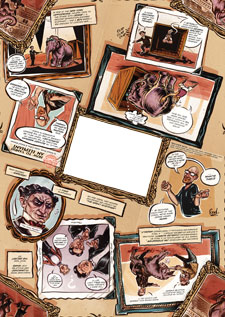
- A cleverly-designed comic combined with a neat geometric illusion is demonstrated
- All students get an cut-it-out-yourself kit for the illusion to take home
- 2 minutes (would need an extra 5 minutes to cut out kits during workshop, plus scissors and paperclips/envelopes for everyone)
- Key concepts:
- There are many fun geometric illusions that do the unexpected
- Several magic tricks John performs uses geometric illusions
Science 3: The importance of calibration
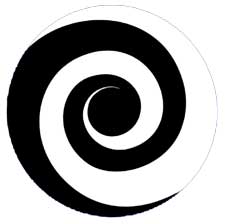
- John's head appears to shrink and an assistant's head appears to grow, after John temporarily miscalibrates specific motion sensors in the brain
- 5 minutes, 1 assistant and all participate
- Key concepts:
- Using uncalibrated equipment can lead to incorrect measurements
- Using calibrated equipment in situations it was not designed for can also lead to incorrect measurements
- Aristotle wrote about the "waterfall" illusion, which this illusion is based, over 2300 years ago
Wrap up 1: Consider being a scientist or engineer
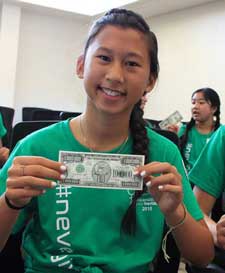
- A magical demonstration of why the world need more scientists and engineers
- 4 minutes, everyone takes home an extraordinary gift (a million dollar bill)
- Key concepts:
- Scientists and engineers turn the ordinary into the extraordinary
- The more scientists and engineers with different skills, backgrounds, worldviews, strength and weaknesses working together, the more that can be accomplished
- One of many reasons why students should consider being a scientist or engineer
Questions 1: Ask an engineer and scientist
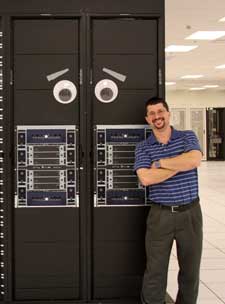
- Students and teachers can ask John questions about working on the world's fastest supercomputers at LLNL, becoming an engineer and scientist, or any other burning questions the workshop raised
- Although John cannot reveal how any of the magic was done, reverse engineering it is always encouraged
- Sierra, the second-fastest supercomputer in the world (in 2019), is made up of over 240 racks of equipment similar in size to the two racks John is standing next to in the photo at the right
- 2-10 minutes (depending on time budget), students ask questions
Additional Wild STEM Magic workshop example modules
These additional Wild STEM Magic modules are also available when creating workshops (as well as many other modules developed after Feb 2019 but not shown below).
Demo 3: Gorilla head illusion
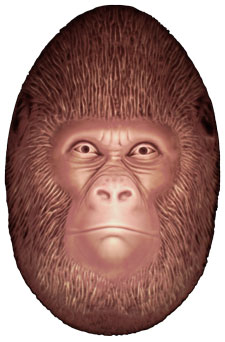
- An intriguing illusion is demonstrated and explained where a floating gorilla head appears to turn dramatically as the viewer changes position
- 4 minutes, all students move around room for 1 minute to view from different perspectives
- Key concepts:
- Although it appears to be a high-tech hologram, it is actually a low-tech hollow-face illusion
- Without careful lighting, shading and shadow cues expose the actual unexpected configuration
- The illusion is often weaker when the gorilla head is turned upside down
- The strong bias of seeing faces as convex may not occur
- However, if you can convince your brain that it is convex, the illusion returns
- For other key concepts, see the Science 2: The science of illusion module
- Demo 3 often combined with Science 2 into a bigger module
Engineering 3: Testing an entropy pump
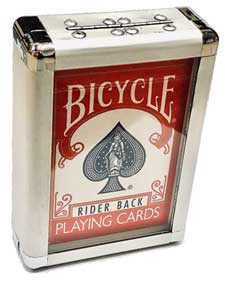
- Students help test a small self-cleaning house prototype, an entropy pump that operates on deck of cards
- Testing the functioning prototype shows that more work is needed before building a full-sized self-cleaning house
- 6 minutes, 2 assistants
- Key concepts:
- Small prototypes are used to test technology when building the full-sized version is too expensive or potentially dangerous
- Refrigerators and air conditioners pump heat out out of a space to make the inside colder
- This prototype attempts to pump chaos out of a space to make it cleaner and more organized
- Random tests and having multiple testers important so you don't only test what you know works
- Investigating anomalies important when testing anything, especially early prototypes
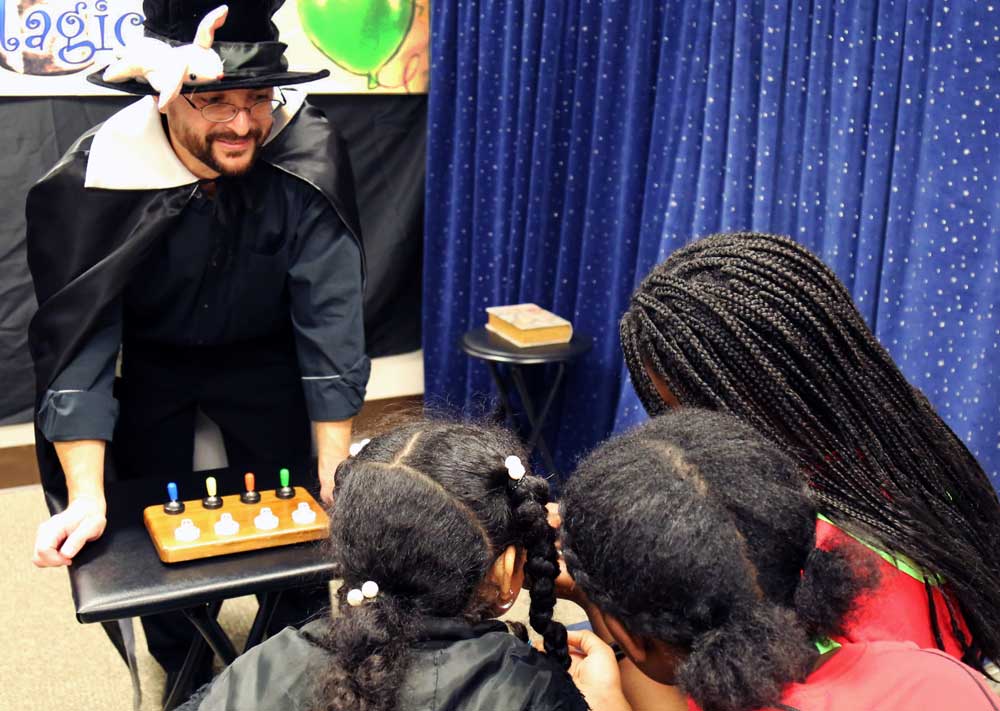
← Back to Wild Hare Magic's home page





















